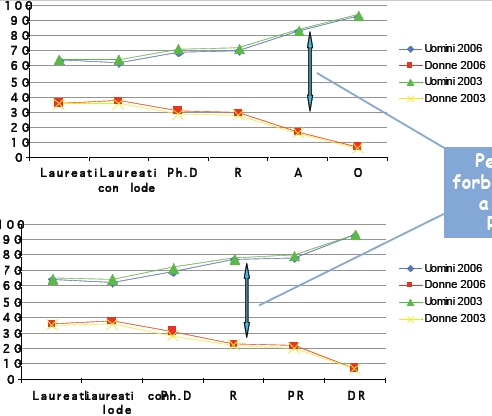I must say I do not fully understand the way the percentages are cooked up, since the first three categories should be the same for the category "university" and "INFN", while they show some minor differences. But let us forget about that part. What is interesting is to observe how the disparity between males and females grows with the level of employment. The first bin contains the M/F fraction for students obtaining a laurea degree; the second shows the fractions for the subset which obtained maximum grades; the third shows the fraction for PhD graduates; and then from the fourth to the sixth bin you can read off the male and female fractions for researchers, associate professors (tenure-track in the US, although associates in Italy are already tenured), and full professors. In the INFN, the last two are represented by "first researchers" and "research directors", which are indeed fully equivalent to the University categories.

You can clearly see that the system preferentially selects males, and that the difference becomes stronger as the level of employment grows. While the fraction of females among excellent students (second column) is about 38% (a datum which increased slightly from 2003 to 2006) -larger than that of the overall graduates-, the recruiting system of physicists in Italian universities and INFN alike preferentially selects men: the fraction drops to 30% for university researchers, and to 8% for the final level of career. Also note that this last datum is constant -the 2003 and 2006 figures agree, showing that this very small fraction of females arriving at the highest level of employment is not due to older and now superseded selection biases (which would likely make the 2003 M/F disparity larger than that in 2006).
An interesting difference exists between the recruitment in university and INFN at the level of simple researchers. While women make up for 30% of physicists who are university researchers, they constitute only 23% of INFN researchers. This is a quite striking effect, well above statistical fluctuations of the base of data used for the graph, and it leaves me wondering. What drives this difference ? I know this question is only interesting to Italians, but if any of you has a tentative explanation of the phenomenon I would be happy to hear it.
The full presentation (sorry, in Italian only) from which I took the graph, by Alessia Bruni, is available here.



Comments